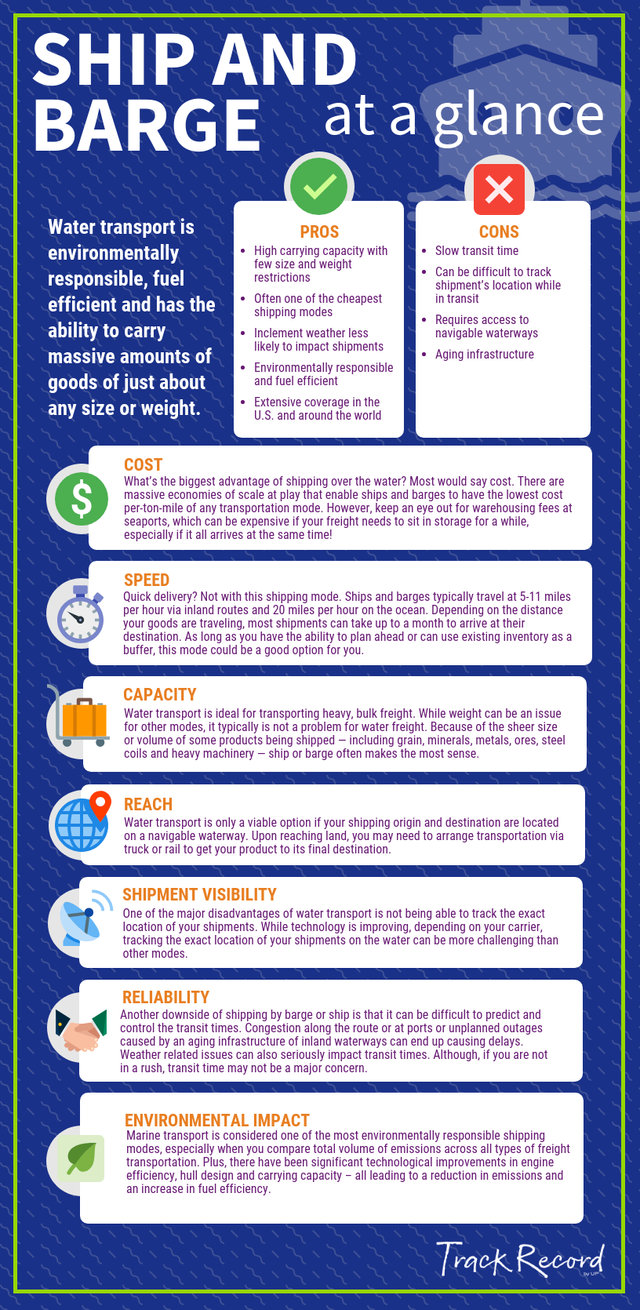
January 24, 2023
Pros & Cons of Water Transport: Ship Speed, Shipment Visibility, More
In Part IV of our transportation mode comparison series, we look to the water. Boats, barges and cargo ships can navigate canals, rivers and oceans to move goods from point A to point B. Is water shipping right for your freight?
Water shipments often have slow transit times, but on the positive side of the water shipping equation are lower costs and environmental impacts. Is water transportation reliable? Will cargo owners know where their freight is on its shipping journey? Keep reading to get these answers and more.

Shipping by Barge and Ship
Transporting goods by barge or ship is a great option for those looking to move bulk items at a low cost. While it is the slowest mode, water transport is environmentally responsible, fuel efficient and has the ability to carry massive amounts of goods of just about any size or weight. Is it right for you?
PROS:
- High carrying capacity with few size and weight restrictions
- Often one of the cheapest shipping modes
- Inclement weather less likely to impact shipments
- Environmentally responsible and fuel efficient
- Extensive coverage in the U.S. and around the world
CONS:
- Slow transit time
- Can be difficult to track shipment’s location while in transit
- Requires access to navigable waterways
- Aging water infrastructure
Cost
What’s the biggest advantage of shipping over the water? Most would say shipping costs. Massive economies of scale come into play that enable container ships and barges to have the lowest cost per-ton-mile of any transportation mode. However, keep an eye out for warehousing fees at seaports, which can be expensive if your freight needs to sit in storage for a while, especially if it all arrives at the same time!
Speed
Quick delivery? Not with this shipping mode. Ships and barges typically travel at 5-11 miles per hour via inland routes and 20 miles per hour on the ocean. Depending on the distance your goods are traveling, most water shipments can take up to a month to arrive at their destination. As long as you have the ability to plan ahead or can use existing inventory as a buffer, this mode could be a good option for you.
Capacity
Water transport is ideal for transporting heavy, bulk freight. While weight can be an issue for other modes, it typically is not a problem for water freight. Because of the sheer size or volume of some products being shipped – including grain, minerals, metals, ores, steel coils and heavy machinery -- ship or barge often makes the most sense. To put things in perspective, an average single 15-barge tow is equivalent to the amount carried by approximately 225 rail cars or 870 tractor-trailer trucks.
Reach
Water transport is only a viable option if your shipping origin and destination are located on a navigable waterway. Upon reaching land, you may need to arrange transportation via truck or rail to get your product to its final destination.
Barges travel on large rivers, or inland waterways, and can transport goods from one city to the next. The inland waterways of the U.S. include more than 25,000 miles of navigable waters, many of them stemming from the Mississippi River. Container ships travel across the ocean carrying enormous amounts of standard shipping containers that can also move by truck or rail. Carrying approximately 90% of the world's manufactured goods, ships are key to international trade. You can bet that many household products and items of clothing you own have spent time in a container aboard a ship on its way to you.
Shipment Visibility
One of the major disadvantages of water transport is not being able to track the exact location of your shipments. While technology is improving, depending on your carrier, tracking the exact location of your shipments on the water can be more challenging than other modes.
Reliability
Another downside of shipping by barge or ship is that it can be difficult to predict and control the transit times due to unforeseen circumstances. Congestion along the route or at ports or unplanned outages caused by an aging infrastructure of inland waterways can end up causing delays. Although, if you are not in a rush, transit time may not be a major concern. Weather related issues can also seriously impact transit times. Periods of high water, low water or ice can negatively impact a barge’s ability to navigate inland waterways. Extreme weather events, like hurricanes and cyclones can also have a huge impact on ocean transit times and port operations.
Environmental Impact
Marine transport is considered one of the most environmentally responsible shipping modes, especially when you compare total volume of emissions across all types of freight transportation. Plus, there have been significant technological improvements in engine efficiency, hull design and carrying capacity – all leading to a reduction in emissions and an increase in fuel efficiency.
Do you have questions about shipping your freight? Answer a few questions and an expert will be in touch.
Related Articles: